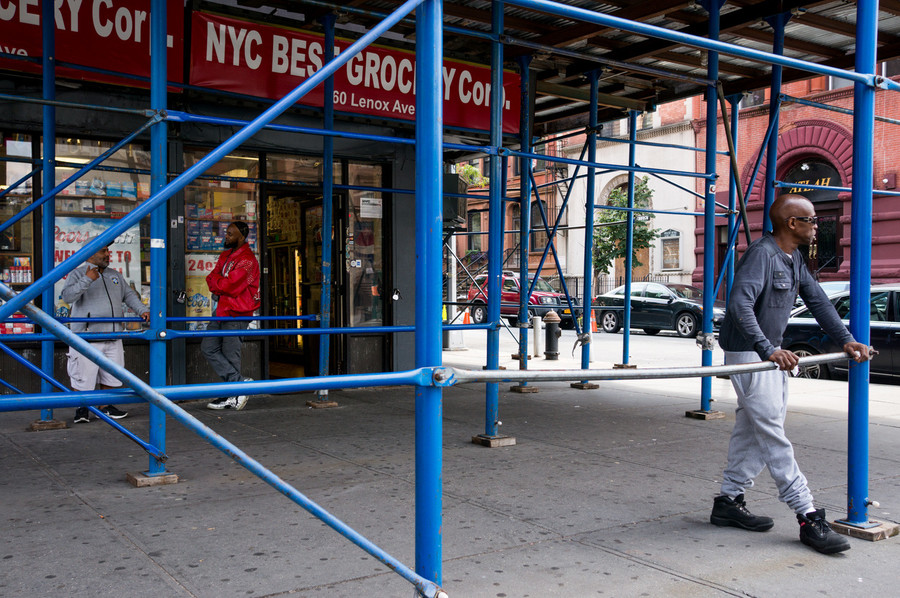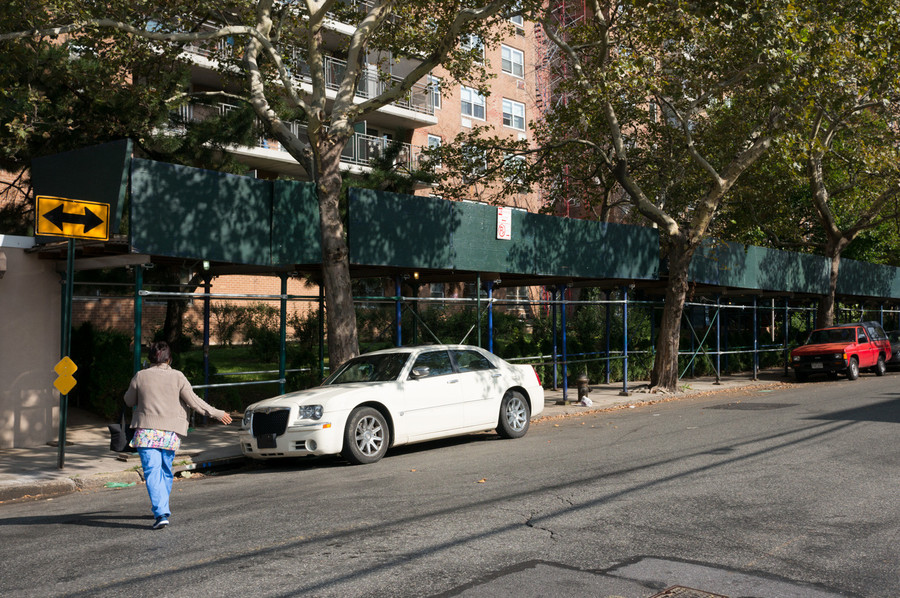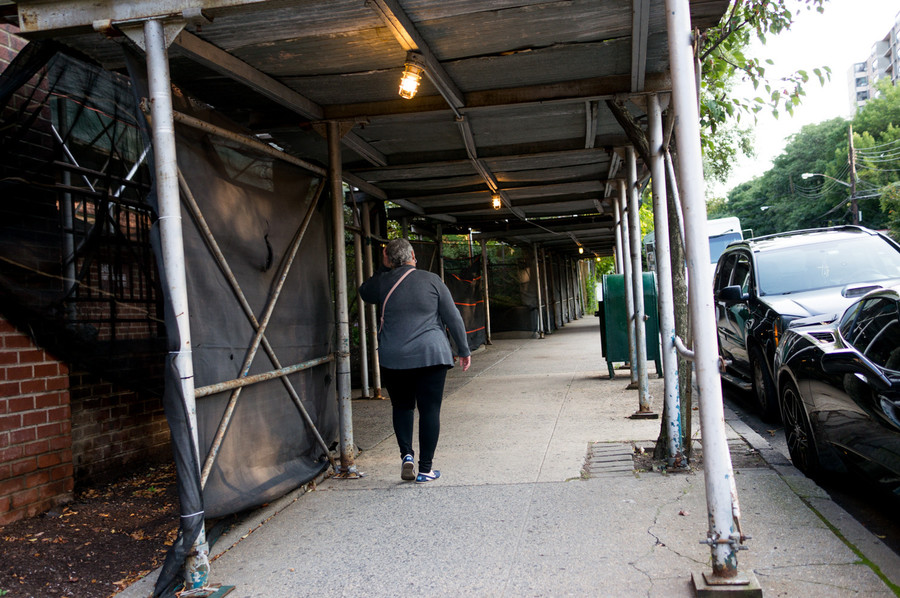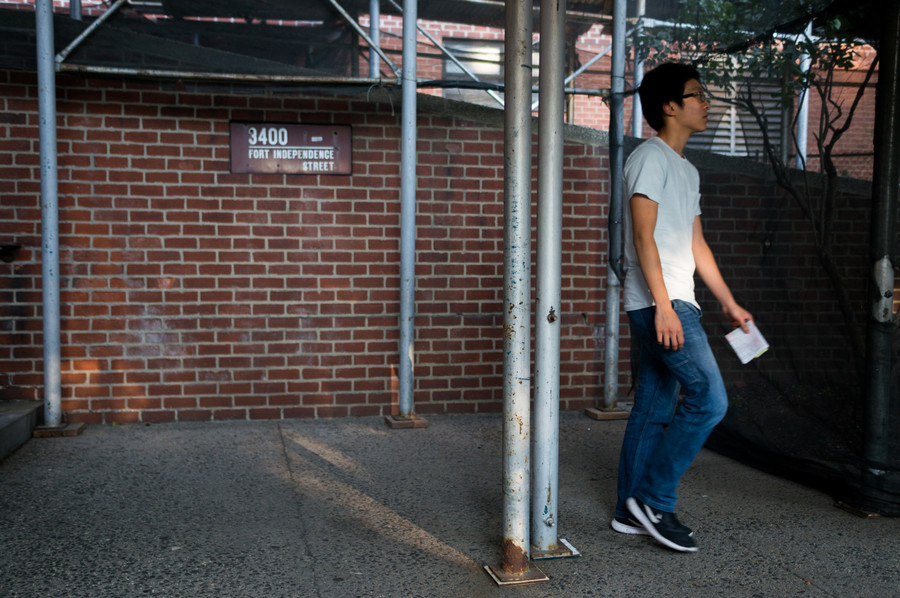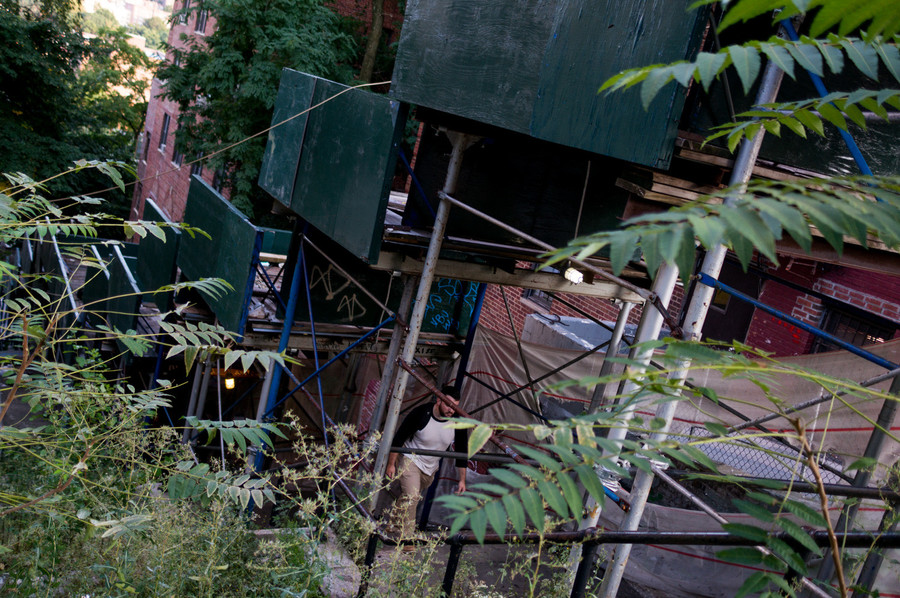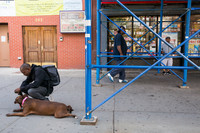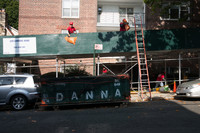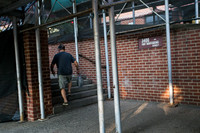Old scaffolds never die, they just rust in place
People generally call them scaffolds, but city officials prefer the term “sidewalk shed.”
No matter what phrase is used to describe them, scaffolds — ahem, sidewalk sheds — are mini-metal jungles, designed to protect pedestrians from falling construction debris. And they’ve become as normal a sight in New York City as taxi cabs and street vendors.
According to the city’s buildings department, there are more than 7,800 sidewalk sheds across the five boroughs — the most, at 3,510, in Manhattan. The Bronx is home to more than 900 of them, with 70 located within the confines of Community Board 8.
Permits for sidewalk sheds typically last a year, or until the contractor’s insurance expires. Leaving these sheds up past a permit could result in fines of $8,000. Yet, renewing these sheds past the first, second, third and even fourth year is easy — until it gets to the point neighbors even forget they’re there.
The oldest permit locally is at 3511 Cambridge Ave., in Spuyten Duyvil, where builders have had the right to use sidewalk sheds since 2008, although much of that scaffolding has since been removed.
But other neighborhoods, not far from Riverdale and Kingsbridge, haven’t had the same luck. Including one sidewalk shed that’s been around since George W. Bush was president.
Attracting undesirables
Mount Morris Park Historic District in central Harlem is perhaps best known for its brownstones, tree-lined streets and nearby Marcus Garvey Park. It’s exactly what made Laurent Delly want to move to the area years before he and his family finally purchased a home there in 2004.
“It was the sheer beauty of the area, the architecture and the history, too,” Delly said of the district, which runs roughly from West 118th Street to West 124th, from Fifth Avenue to Adam Clayton Powell Jr. Boulevard.
When he first moved in, a nearby building — 260 Lenox Ave. — was surrounded by a sidewalk shed. At first, Delly thought nothing of it, since this was New York City after all, and the building was just a few stories tall. It won’t be there forever.
Yet it has. Some 12 years later, the shed remains while the quality of life for Delly and his neighbors are long gone.
“It’s every stress you can imagine fellow human beings giving you,” he said. “It’s what we’ve been exposed to every single day — urination, human feces, noise.”
By law, sidewalk sheds are required to protect people from potential falling objects, remaining there “until there’s no longer a danger to the public,” said Andrew Rudansky, a spokesman for the city’s buildings department.
The L-shaped structure at 260 Lenox runs along a portion of the uptown side of West 123rd Street and Lenox Avenue, stretching down a block that’s part of Mount Morris Park West.
Delly and other residents who live between Lenox and Mount Morris Park West — which includes families with young children — walk in the street or on the other side of the block to avoid the structure. Not because they’re worried about the structural sound of the sidewalk shed, but more because of the “undesirable elements” it attracts.
“We’ve been under severe stress with the magnitude and sheer noise in the morning hours,” Delly said. “Even 3 o’clock in the morning, you’ll hear someone say, ‘Hey, yo,’ hollering like you are somewhere else. And there is only one cause — the cause is the scaffold.”
Bad for business?
Covering a residential building is difficult for neighbors. But when sidewalk sheds start obscuring businesses, like it does along West 231st Street near Broadway, it offers a new set of problems.
The sidewalk shed here popped up in recent months in front of stores like Estela Hair Salon, First Class Professional Alterations, Boost Mobile, Bronx Barber Shop and 3 Star Deli and Grocery.
With signs on the front of the building blocked, these businesses are legally allowed to put up temporary signage on the shed itself — but it doesn’t necessarily help reminding potential customers they’re there. And while the current permit is set to expire next June, no one knows how long they can expect this particular shed to remain up.
Rafael Estrella is the owner of First Class Professional Alterations, a tailor shop where customers can get clothing fixed and resized. He’s operated out of West 231st for 11 years, and this past month was the first time he saw a sidewalk shed appear in front of his business.
Regular customers keep returning, but a few told him the scaffolding confused them — they thought Estrella’s shop was closed. And he doesn’t even want to begin to think of how many potentially new customers he might have lost.
“They cannot see the name of the store,” Estrella said. “If a customer stops by, they’ll think that everything (is under) construction around here.”
For the Boost Mobile store next door, similar concerns have cropped up.
Elve Rahman, a store representative for the cellular company, said a few changes were made to the exterior of the store since the sidewalk shed went up to help continue attracting customers. But it’s been hard. Before the construction, Boost had tables and signs outside to get attention. Now, there is almost no space — or visibility — at all.
“We can’t advertise our products properly,” Rahman said. “We are not supposed to take our tables outside and set them up properly. Customers miss the signs.”
New business is now down, he added. And there’s no end in sight.
“I thought (construction) would be done within a month,” Rahman said. “It’s not getting any better.”
Making the law work
But the cries from people like Laurent Delly, Rafael Estrella and Elve Rahman haven’t gone unheeded.
Councilman Ben Kallos doesn’t represent the Bronx, but he bets he knows what the views are like.
“We are in the unfortunate situation where if I am standing under one scaffolding in the city, I can look around and see another set of scaffolding,” said Kallos, who represents the Upper East Side and Midtown. “There’s scaffolding everywhere — there is literally hundreds of miles of it.”
Yet, sidewalk sheds are nearly impossible to enforce, Kallos said, because the law only requires scaffolding to be put up and for landlords to have a permit for it. There’s nothing in the law that dictates when such scaffolding needs to come down.
“There is scaffolding in this city that is almost old enough to vote,” he said. “It is a problem all over the city.”
The existing law, according to Councilman Andrew Cohen, creates an environment like the one that allowed sidewalk sheds to stay in front of the historic Tracey Towers at 20 and 40 W. Mosholu Parkway S., for four years.
“That recently came down, and that was transformative,” Cohen said. “It was unsightly and, you know, disruptive. There was a celebratory mood at Tracey Towers when the scaffolding came down, that’s for sure.”
Yet, there could be hope for people sick of living with sidewalk sheds. Last year, Kallos introduced a bill to city council placing time limits on how long scaffolding can be left in front of buildings.
The bill proposes a hard, six-month deadline for sidewalk sheds, requiring workers be present six days a week, and that work not stop for more than seven days at a time while such scaffolding is in place.
If a landlord can’t afford — or worst yet, doesn’t want to do — the work, Kallos said the city would step in and bill the landlord later.
“Deadlines are good things — it’s how things get done,” Kallos said. “It’s how every other part of the private sector works.”
Yet, it’s not how things get done in city council. Debate hasn’t opened on the bill yet because he needs 30 council members to sign on. His tally so far? Just two — Ydanis Rodriguez, whose district dips into Marble Hill, and Karen Koslowitz in Forest Hills.
One of the bill’s biggest enemies, Kallos said, could very well be the real estate lobby — groups like the Real Estate Board of New York, and the Rent Stabilization Association. In fact, when the bill was first proposed, Real Estate Board senior vice president Carl Hum called it “ill-conceived.” RSA representatives blasted the bill because it doesn’t account for the financial burden landlords would have to shoulder to pay for the work in these shorter spurts of time.
Cohen has a different idea, however. He thinks Kallos’ bill is too stringent, and although he is open to changing the way sidewalk sheds are regulated, he prefers a system with fees instead of hard deadlines.
‘Necessary for safety’
Despite the problems surrounding sidewalk sheds, they do indeed serve a purpose in protecting the public. The U.S. Department of Labor has said that of the nearly 4,400 on-the-job fatalities in worksites around the country in 2015, more than 21 percent of them — or nearly 940 — came in construction.
In fact, construction accidents are the leading causes of private sector fatalities — not including highway collisions. While falls were the primary culprit, being struck by objects accounted for nearly 10 percent of those deaths. And sidewalk sheds prevent those numbers from bleeding into the general public.
And sidewalk sheds don’t bother everyone. Back on West 231st, Marilyn Romero and Louis Salas — a hairstylist at Estela Hair Salon and a barber at Bronx Barber Shop — said they were unfazed by the sudden appearance of the sidewalk shed in front of their businesses.
In fact, Romero said there has been no change in the number of customers coming into Estela over the last month. And customers filled every seat at the barbershop, with a small line waiting to join them.
Government officials don’t forget about sidewalk sheds, buildings department spokesman Rudansky said, and last year an inspection of the more than 7,800 sidewalk sheds revealed that 98 percent “were found to be necessary for public safety.”
Yet, not a day goes by that scaffolding doesn’t affect the life of Laurent Delly near the 12-year-old structure in his Harlem neighborhood. And while he could surely move somewhere else, he’s going to keep fighting to make sure it’s the sidewalk shed that moves instead.
“I am not going to let them win,” Delly said. “We are determined to take action to get this thing resolved in a professional manner.”
Want to see where all the scaffolds are in this area? Curious to know more about sidewalk sheds, and how it has infested our community? See the Sept. 14 print edition of The Riverdale Press.

